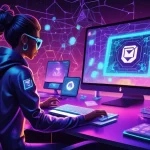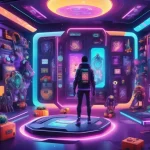Artprice’s AI Revolution in Art Valuation: Blockchain and NFT Potential Explored

AI Meets Art: Artprice’s Tech Revolution and Its Blockchain Potential
Artificial Intelligence is tearing through traditional markets, and the art world is getting a front-row seat to the upheaval. On June 15, 2025, the Franco-German TV channel Arte broadcast a gripping documentary, “AI and the Art Market,” spotlighting Artprice by Artmarket and its game-changing AI tools that are redefining art valuation and transparency. Led by visionary founder Thierry Ehrmann, Artprice isn’t just crunching numbers—it’s setting the stage for a digital revolution that could intersect with blockchain and cryptocurrency in profound ways.
- AI Disruption: Artprice’s Intuitive Artmarket® and Blind Spot AI® are revolutionizing art valuation and market insights with unprecedented data power.
- Global Leader: Boasting a database of over 30 million auction results, Artprice serves 9.3 million users across 119 countries.
- Blockchain Synergy: AI’s role in digital art valuation hints at massive potential for NFTs and provenance tracking on decentralized platforms.
Artprice’s AI Arsenal: Redefining the Art Game
At the heart of Artprice’s dominance is a database that’s nothing short of staggering—over 861,000 artists, 30 million auction results, and 181 million digital images of artworks from 1700 to the present day. Partnering with 7,200 auction houses and reaching 9.3 million users in 119 countries, their influence is global. They push content to 6,300 newspapers in 11 languages, making art market intel more accessible than ever. But the real magic kicked in on January 9, 2025, with the launch of their proprietary AI tools: Intuitive Artmarket® and Blind Spot AI®. These aren’t just fancy buzzwords—they’re transforming how art is valued, bought, and understood, as highlighted in a recent documentary analysis by Arte and Perplexity_AI Labs.
For the uninitiated, let’s break this down. Art valuation used to be a murky, insider-driven process—think hushed auction rooms and subjective appraisals. Intuitive Artmarket® acts like a predictive engine, analyzing trends and forecasting values with eerie accuracy, almost like a stock market algo for paintings. Blind Spot AI®, on the other hand, is a digital sleuth, using image recognition to identify artworks or spot market anomalies—think of it as a detective catching fakes before they hit the block. Artprice processes a mind-boggling 35MB of data per second per employee, a rate that leaves European averages eating dust by a factor of 20. That’s like streaming multiple HD movies every second, just to keep up with the art world’s pulse. This level of transparency and data muscle mirrors the kind of radical openness we push for in crypto with decentralized ledgers, much like the innovations discussed on Reddit forums about Artprice’s AI tools and NFTs.
Recognition for their work isn’t just anecdotal. At the CIHA Lyon 2024 congress, 86% of 378 attendees crowned Artprice as the top art market database, a testament to their credibility. An independent analysis by Perplexity Labs, known for near-zero error rates thanks to official source data, further lauded their strategic positioning and tech innovation. It’s clear Artprice isn’t playing catch-up—they’re setting the pace, as detailed in their comprehensive Wikipedia profile on AI-driven market impact.
“Artprice stands as the undisputed world leader in art market information, distinguished by its comprehensive database covering over 861,000 artists and 30 million auction results spanning more than three centuries of art history.” – Artprice Description.
Cultural Rebellion: La Demeure du Chaos
Beyond raw data, there’s a cultural edge to Artprice’s story. Their headquarters, La Demeure du Chaos (Abode of Chaos), in France, isn’t your typical corporate office. It’s a contemporary art museum that’s welcomed 2.5 million visitors since 2006, a chaotic blend of creativity and commerce. On March 20, 2025, France’s Minister of Culture, Rachida Dati, declared it a “total work of art,” cementing its status as a cultural landmark. Founded by Thierry Ehrmann, who’s as much artist as entrepreneur, this space embodies disruption—much like Bitcoin’s genesis block was a defiant jab at centralized finance. It’s a physical reminder that challenging the status quo isn’t just tech’s domain; it’s a mindset, further explored in recent news on Ehrmann’s cultural impact. For us in the crypto space, this resonates deeply—disrupting elitist systems, whether in art or money, is the name of the game.
Bridging to Blockchain: NFTs and Digital Art
While the Arte documentary doesn’t dive into blockchain, the parallels to our world are impossible to ignore. The art market’s digital shift, especially with Non-Fungible Tokens (NFTs) exploding to a $2.9 billion trading volume at their 2021 peak (per Chainalysis), screams for tools like Artprice’s. NFTs, for those new to the term, are unique digital assets verified on a blockchain, often representing art or collectibles. A key pain point is provenance—the documented history of ownership—and scams with inflated valuations or outright forgeries. Enter Artprice’s AI. Imagine Blind Spot AI® cross-referencing an NFT’s digital signature on a blockchain like Ethereum to confirm authenticity, or Intuitive Artmarket® providing real-time pricing data for tokenized art sales on decentralized marketplaces. This isn’t far-fetched; it’s a logical next step, supported by studies on NFT provenance tracking using AI technology.
Let’s paint a picture. Picture a digital artist minting an NFT for a virtual gallery. A buyer wants assurance it’s not a knockoff and the price isn’t hyped nonsense. Artprice’s AI could validate the piece’s origin and suggest a fair value based on market trends, while a smart contract—self-executing code on a blockchain—automates the sale without middlemen, cutting fees and ensuring trust. Bitcoin could even act as a settlement layer for high-value transactions, leveraging its security, while Ethereum handles the tokenized ownership. This synergy could birth a robust ecosystem for digital art, merging AI precision with blockchain’s immutability, a concept gaining traction in discussions about AI’s influence on NFT valuation. France’s push to be the third-largest AI hub by 2029, which Artprice aligns with, parallels blockchain-friendly policies in places like Singapore, hinting at a global tech convergence we should all be watching.
Historical context adds weight here. The NFT boom of 2021 saw astronomical sales—like Beeple’s “EVERYDAYS” fetching $69 million at Christie’s—but the 2022-2023 cooldown exposed flaws, with trading volumes dropping over 70% (per DappRadar). Wash trading and scams ran rampant, eroding trust. Artprice’s tech could be the antidote, bringing data-backed legitimacy to a space still finding its footing. This isn’t just about art; it’s about redefining value in a digital age, a mission crypto folks live for.
The Dark Side: Risks of AI in Art and Crypto
Before we get carried away with utopian visions, let’s slap some reality on the table. AI, much like crypto in its wild early days, comes with serious baggage. Broader societal dangers loom—algorithmic bias, privacy erosion, and job displacement in creative fields are real threats. Some experts warn of psychological fallout if AI outpaces human creativity, leaving artists feeling irrelevant. In crypto, we’ve seen AI trading bots fuel scams or manipulate markets with fake volume. Artprice’s tools are impressive, but what’s stopping bad actors from gaming valuations, just like wash trading plagues NFT platforms? Could AI turn art into another soulless Wall Street ticker, stripping its essence? We’re all for effective accelerationism—pushing tech to break barriers—but not if it screws over ethics or the human spirit, a concern echoed in broader predictions about AI’s future impact.
Real-world parallels drive this home. AI-generated art controversies, like tools spitting out copyrighted styles without credit, highlight ethical minefields. In financial markets, flawed algorithms have crashed portfolios overnight. If Artprice’s tech over-centralizes data power, it risks contradicting the decentralization we champion in crypto. Imagine a future where a handful of AI platforms dictate art’s worth—sounds a lot like the banking cartels Bitcoin was built to defy. Disruption is our gospel, but blind trust in tech is a rookie mistake. We’ve got to push boundaries while keeping one eye on the shadows.
Global Tech Trends: France’s AI Push and Crypto Echoes
Zooming out, Artprice’s story fits into a larger narrative of tech sovereignty. France’s ambition to become a global AI leader by 2029 isn’t just policy fluff—it’s a cultural power play, much like Estonia’s blockchain experiments or Dubai’s crypto hubs. Artprice’s roadmap syncs with this vision, bolstered by partnerships like their 15-year collaboration with Chinese state group Artron for global auction coverage. This isn’t just about art; it’s about positioning tech as the new frontier of influence. For crypto enthusiasts, this mirrors how blockchain adoption often ties to national strategies—think El Salvador’s Bitcoin gamble. The convergence of AI and decentralized tech could redefine markets from art to money, and France’s moves are a signal worth heeding, especially with emerging trends in AI and NFT markets for 2025.
Key Takeaways and Questions for Crypto Enthusiasts
- How is AI reshaping the art market through Artprice?
Artprice uses AI tools like Intuitive Artmarket® for predictive valuation and Blind Spot AI® for image recognition, bringing transparency to a historically opaque market with a database of over 30 million auction results. - Why does this matter to the crypto community?
The focus on digital art valuation directly ties to NFT markets, where issues of authenticity and pricing are rampant, making Artprice’s tech a potential game-changer for blockchain-based assets. - Can AI and blockchain work together in digital art?
Yes, AI could validate NFT authenticity and pricing, while blockchain ensures immutable ownership records, creating a trusted ecosystem for creators and buyers alike. - What risks does AI pose in markets like art or crypto?
Dangers include bias in algorithms, privacy violations, and market manipulation, akin to how AI bots can distort crypto trading if left unchecked. - Is this genuine disruption or just tech hype?
The disruption is real, with tangible tools and data backing Artprice’s impact, but ethical and technical challenges temper the optimism—progress, not perfection, is the goal.
Stepping back, Artprice’s journey isn’t just an art market tale—it’s a blueprint for how tech can dismantle entrenched systems, a narrative we breathe in the crypto space. Their blend of AI innovation and cultural rebellion echoes Bitcoin’s own fight against the old guard. Yet, as we root for this fusion of AI, art, and potential blockchain applications, let’s not ignore the pitfalls. Overreliance on algorithms could mirror crypto’s growing pains—trusting code over common sense. Still, if we play this right, tokenizing creativity while preserving trust could be the next big leap. And if that’s not a revolution worth tracking, then hell, I don’t know what is.



